Application of Multivariate Statistical Analysis in Evaluation of Surface River Water Quality of a Tropical River
Abstract
The present study evaluated the spatial variations of surface water quality in a tropical river using multivariate statistical techniques, including cluster analysis (CA) and principal component analysis (PCA). Twenty physicochemical parameters were measured at 30 stations along the Batang Baram and its tributaries. The water quality of the Batang Baram was categorized as “slightly polluted” where the chemical oxygen demand and total suspended solids were the most deteriorated parameters. The CA grouped the 30 stations into four clusters which shared similar characteristics within the same cluster, representing the upstream, middle, and downstream regions of the main river and the tributaries from the middle to downstream regions of the river. The PCA has determined a reduced number of six principal components that explained 83.6% of the data set variance. The first PC indicated that the total suspended solids, turbidity, and hydrogen sulphide were the dominant polluting factors which is attributed to the logging activities, followed by the five-day biochemical oxygen demand, total phosphorus, organic nitrogen, and nitrate-nitrogen in the second PC which are related to the discharges from domestic wastewater. The components also imply that logging activities are the major anthropogenic activities responsible for water quality variations in the Batang Baram when compared to the domestic wastewater discharge.
1. Introduction
The Batang Baram (“batang” denotes big river) (coordinates: 4°35′5.28′′N and 113°58′44.256′′E) is located on the northern part of Sarawak where it flows 400 km westwards, mostly through primary and secondary forest to the South China Sea. The river is the second longest river in Sarawak and the third longest river in Malaysia. The Baram area was once a pristine area but it has undergone profound changes associated with the population growth and development. Increasing residential area, numerous longhouses, and swidden agriculture are found along the river. Commercial logging has also been carried out actively in the area for decades where the logged forest was then converted to commercial oil palm and acacia plantations [1].
Although development continues to grow in this area, the study on the water quality of the river is relatively scarce despite the river serving as an important source for drinking water for the rural community. The discharges of domestic sewage and agricultural runoff can lead to eutrophication [2–4] while deforestation can cause sedimentation and nutrient enrichment in the river [5–8]. In the year 1995, sampling was conducted in the uppermost catchment of the Baram River basin. The study revealed that the overall water quality of the river was relatively good at that time but was subjected to high suspended solids which came from soil erosions due to land clearing and timber harvesting [9]. The author also pointed out that elevated ammonia was found near to the domestic and animal waste discharges.
Water quality assessment and monitoring on large river basin like the Batang Baram potentially generate a large data set. Numerous studies have shown that multivariate statistical analysis is useful for the assessment of the spatial water quality variations in a river [10–16]. Cluster analysis could reveal similarities among the large number of sampling stations in a river while principal component analysis assists in identifying important factors accounting for most of the variances in water quality of a river. Hence, the aim of the present study was to apply the multivariate statistical analysis in the interpretation of the physicochemical characteristics of the Batang Baram and its tributaries. The analysis output would provide valuable information for the decision making in the river basin management.
2. Materials and Methods
2.1. Field Collection
In situ and ex situ parameters were collected at 30 sampling stations located along the Batang Baram and its tributaries covering a distance of approximately of 172 km (Figure 1). Table 1 shows the details of the samplings from upstream to downstream directions that were carried out in the year 2015. The water level of river was high during samplings due to the rain before each sampling. The whole study area was subjected to logging activities. Numerous longhouses and plantation activities were included in Table 1. In situ parameters including temperature, pH, conductivity, oxygen saturation (DOsat), dissolved oxygen (DO), and turbidity were measured using a multiparameter water quality sonde (YSI6920 V2-2). Transparency, depth, and flow velocity were measured using a Secchi disc with a measuring tape, a depth sounder (PS-7, Hondex), and a stream flow meter (Geopacks), respectively. Total discharge, mean velocity, and mean depth were calculated according to [17]. The water samples were taken for the analyses of chlorophyll a (chl a), total suspended solids (TSS), five-day biochemical oxygen demand (BOD5), chemical oxygen demand (COD), total phosphorus (TP), total ammonia nitrogen (TAN), nitrite-nitrogen (-N), nitrate-nitrogen (-N), organic nitrogen (Org-N), and total sulphide (TS). All sampling bottles were acid-washed, cleaned, and dried before use. Analyses of chl a, TSS, and BOD5 began in the field immediately after sampling while -N, -N, and TS analyses were completed in the field after sampling. Water samples were acidified to pH < 2 for COD, TP, TAN, and Org-N analyses. The samples were placed in an ice box and transported to the laboratory for further analysis [18].
| Sampling | Station | Location | Remark |
|---|---|---|---|
| 29-30 July 2015 | St 1 |
|
Lio Mato longhouse |
| St 2 |
|
||
| St 3 |
|
Long Tungan longhouse | |
| St 4 |
|
||
| St 5 |
|
||
| St 6 |
|
Long Semiyang longhouse | |
| St 7 |
|
||
| St 8 |
|
||
| St 9 |
|
||
| St 10 |
|
|
|
| 3-4 September 2015 | St 11 |
|
Long Apu longhouse |
| St 12 |
|
Residential area | |
| St 13 |
|
||
| St 14 |
|
||
| St 15 |
|
Long San longhouse | |
| St 16 |
|
Residential area | |
| St 17 |
|
||
| St 18 |
|
Long Sangah longhouse | |
| St 19 |
|
Long Naha’a longhouse | |
| St 20 |
|
||
| 21-22 January 2015 | St 21 |
|
|
| St 22 |
|
||
| St 23 |
|
||
| St 24 |
|
||
| St 25 |
|
||
| St 26 |
|
Long Kesseh longhouse | |
| St 27 |
|
Long Kesseh longhouse | |
| St 28 |
|
|
|
| St 29 |
|
||
| St 30 |
|
||
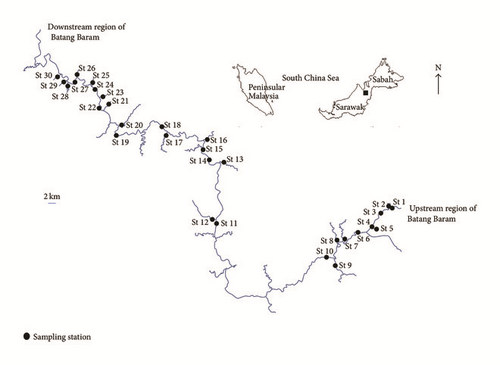
2.2. Laboratory Analysis
A calibration curve was constructed for each chemical analysis. The blank and standard solutions were treated in the same way as the sample.
2.3. Water Quality Index (WQI)
2.4. Statistical Analysis
Comparison of physicochemical parameters between the stations in the Batang Baram was conducted using one-way ANOVA and Tukey’s pairwise comparisons with 5% significance level. The independent samples t-test was used to compare the physicochemical parameters between the main river and tributary stations. Pearson’s correlation analysis was performed to determine the relationship among all the parameters. Cluster analysis (CA) was used to investigate the grouping of the sampling stations by using the physicochemical parameters collected in the river. Z-score standardization of the variables and Ward’s method using Euclidean distances as a measure of similarity were used. The cluster was considered statistically significant at a linkage distance of <60% and the number of clusters was decided by the practicality of the outputs [12]. Principal component analysis (PCA) was conducted to characterize the loadings of all physicochemical parameters for each of the PCs obtained having eigenvectors higher than one (Kaiser criterion). The component has significant loading on a variable when the loading is greater than 0.4 [20]. The data were square-rooted and standardized prior to the analysis. The quality of data for PCA was confirmed with Kaiser-Meyer-Olkin (KMO) measure of sampling adequacy test and Bartlett’s test of sphericity. All the statistical analyses were carried out by using the Statistical Software for Social Sciences (SPSS Version 22, SPSS Inc., 1995).
3. Results and Discussion
3.1. The Physicochemical Characteristics of the Batang Baram and Its Tributaries
Figures 2 and 3 show the mean values of the physicochemical parameters of the Batang Baram and its tributaries from upstream to downstream regions. During the sampling, total discharge of the Batang Baram ranged from 126.3 m3/s to 2711.8 m3/s and from 0.5 m3/s to 133.6 m3/s in main river and tributaries, respectively. Figure 2 illustrates that total discharge of main river showed an increasing trend towards downstream regions whereas the highest total discharge in tributaries was observed at station 8 followed by station 16. Mean velocity of the river was relatively consistent in main river with a mean value of 1.2 m/s. High mean velocity (>1 m/s) was also observed in some of the tributaries located upstream but most of the tributaries were slow flowing (≈0.2 m/s). Mean depth of the Batang Baram ranged from 0.9 m to 16.5 m and from 0.2 m to 6.1 m in main river and tributaries, respectively. Both main river and tributaries were relatively deeper downstream compared to upstream.
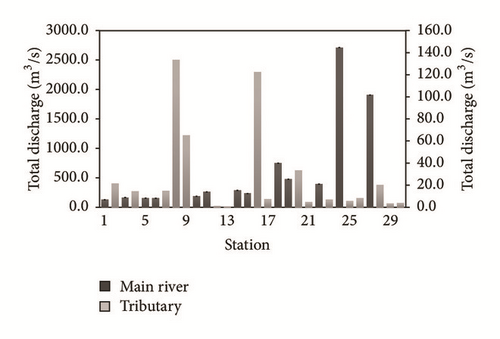
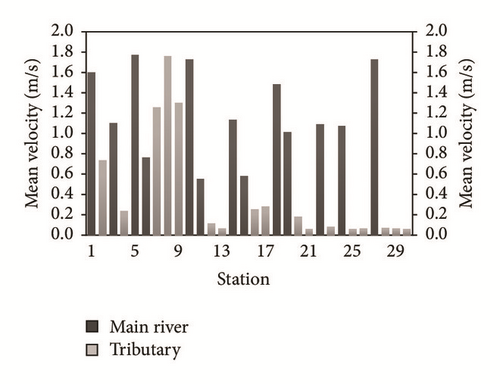
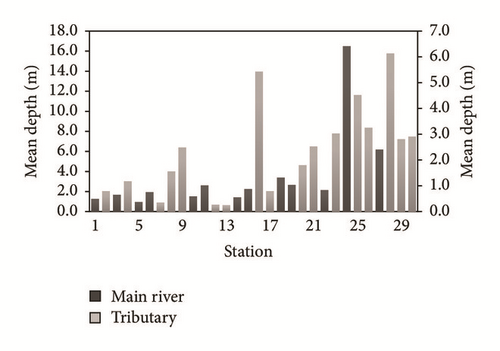
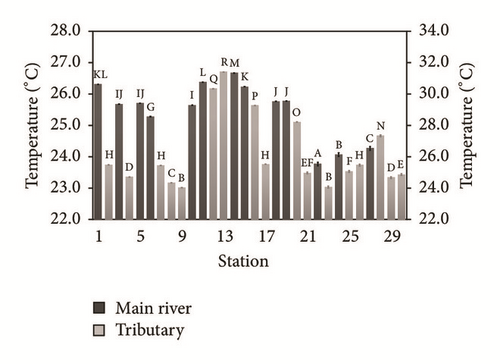
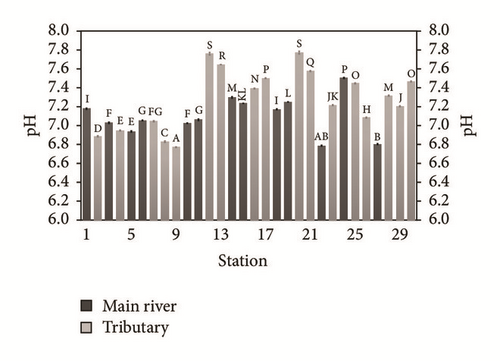
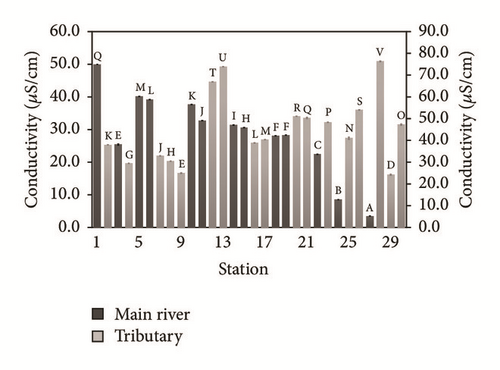

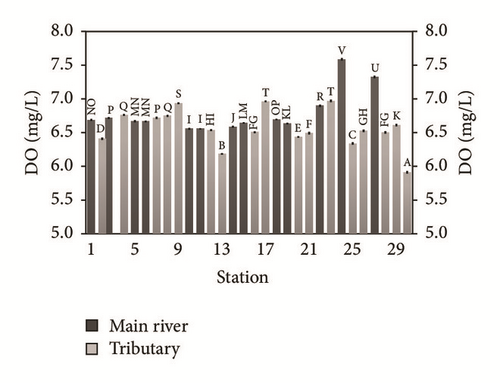
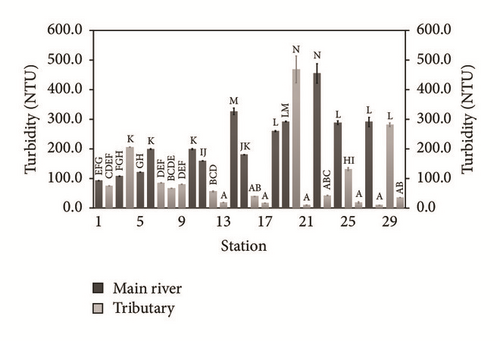
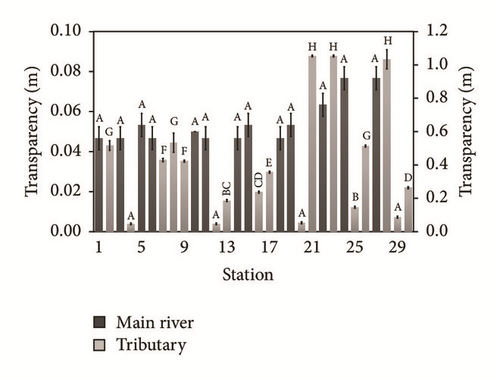
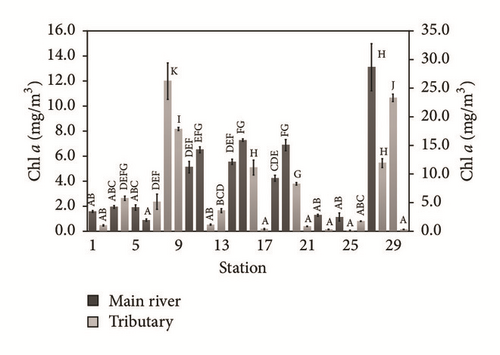
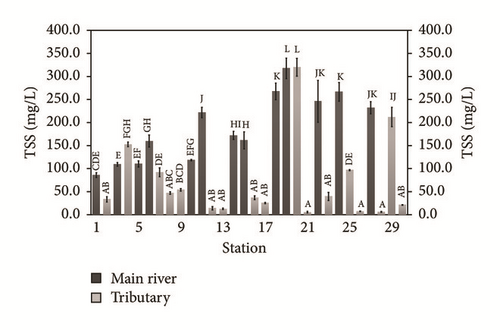
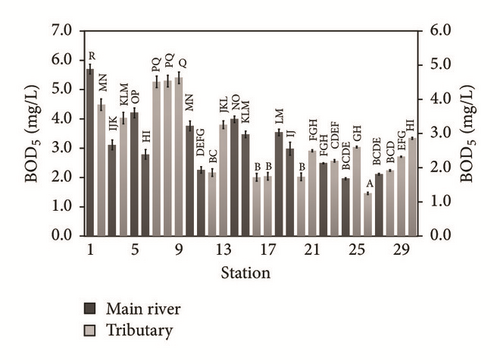
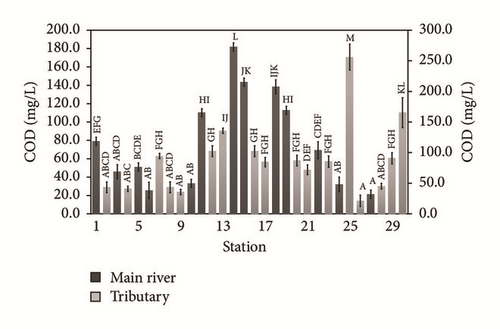
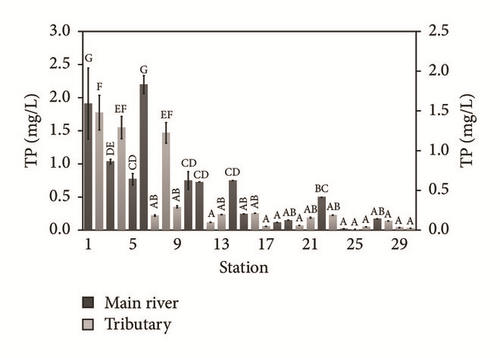
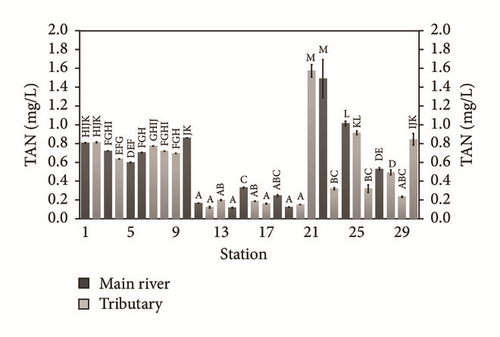
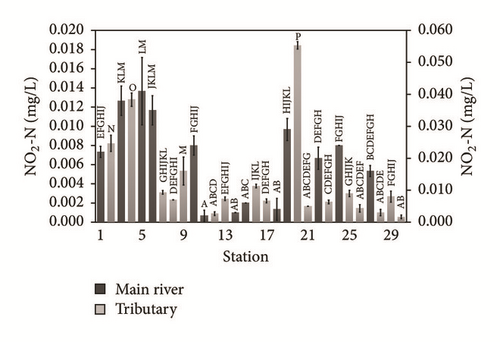
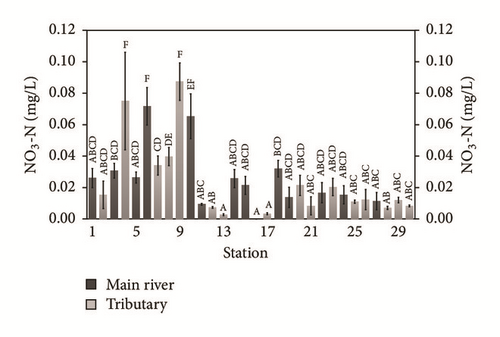
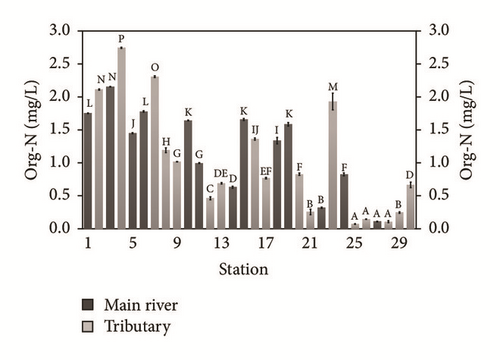
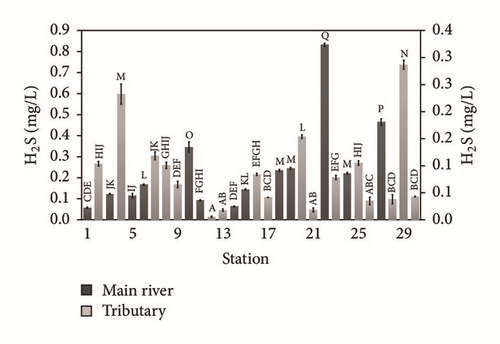
The results of ANOVA showed that all of the parameters demonstrated significant variations (p value ≤ 0.05) from one sampling station to another. The physicochemical parameters showed different distribution patterns along the main river. The turbidity, TSS, and H2S values increased significantly (p value ≤ 0.05) towards downstream with the highest values of turbidity (468.8 ± 45.4 NTU) and TSS (320.0 ± 19.3 mg/L) which were both observed at station 20 while the highest value of H2S (0.83 ± 0.01 mg/L) was observed at station 22. The high turbidity and TSS downstream indicate the accumulation of sediment in the river. Reference [21] reported that a spit was formed in the Baram River mouth and continued to expand due to the erosion associated with deforestation and land use changes in the upstream region. The similar distribution pattern and significant positive correlation (p value ≤ 0.05) between H2S, turbidity, and TSS (Table 2) indicated that H2S was associated with suspended solids in the river.
| Discharge | Velocity | Depth | Temp | pH | Cond | DOsat | DO | Turb | Trans | Chl a | TSS | BOD5 | COD | TP | TAN | -N | -N | Org-N | H2S | |
|---|---|---|---|---|---|---|---|---|---|---|---|---|---|---|---|---|---|---|---|---|
| Discharge | .392 | .834 | −.546 | .601 | .706 | .389 | ||||||||||||||
| Velocity | .392 | −.391 | −.511 | .381 | −.389 | .555 | .491 | .454 | ||||||||||||
| Depth | .834 | .641 | .513 | |||||||||||||||||
| Temp | .658 | .610 | −.480 | −.528 | −.390 | −.403 | ||||||||||||||
| pH | −.546 | −.391 | .658 | .549 | −.539 | −.650 | .413 | −.608 | −.566 | |||||||||||
| Cond | −.511 | .610 | .549 | −.444 | .478 | −.467 | −.554 | −.454 | ||||||||||||
| DOsat | −.539 | −.582 | .915 | .714 | ||||||||||||||||
| DO | .601 | .641 | .527 | −.544 | −.456 | −.547 | .362 | |||||||||||||
| Turb | .706 | .381 | .513 | −.480 | −.650 | .527 | .366 | −.493 | .399 | |||||||||||
| Trans | −.389 | .413 | −.582 | −.605 | −.361 | |||||||||||||||
| Chl a | ||||||||||||||||||||
| TSS | .389 | −.608 | .915 | .366 | −.605 | .596 | ||||||||||||||
| BOD5 | .555 | −.444 | −.544 | .550 | .545 | .523 | ||||||||||||||
| COD | .478 | −.493 | −.392 | |||||||||||||||||
| TP | .491 | −.467 | −.456 | .550 | .540 | .564 | ||||||||||||||
| TAN | −.528 | |||||||||||||||||||
| -N | ||||||||||||||||||||
| -N | .454 | −.390 | −.554 | .545 | −.392 | .540 | .515 | |||||||||||||
| Org-N | −.547 | .523 | .564 | .515 | ||||||||||||||||
| H2S | −.403 | −.566 | −.454 | .714 | .362 | .399 | −.361 | .596 |
On the other hand, the conductivity, BOD5, TP, -N, and Org-N showed higher values at the upper part of the river and decreased significantly (p value ≤ 0.05) towards downstream region. In contrary, [22] demonstrated that TP, TN, and NH3-N concentrations tend to increase from upstream to downstream regions in the Qiantang River, East China. In the present study, the highest conductivity value was observed at station 1 (50.0 μS/cm) and steadily decreased to 3.5 μS/cm at station 27. The highest values of BOD5 (5.7 ± 0.2 mg/L) and Org-N (2.74 ± 0.01 mg/L) were observed at stations 1 and 4, respectively, while the highest values of TP (2.2 ± 0.1 mg/L) and -N (0.07 ± 0.01 mg/L) were observed at station 6. The conductivity value (82 μS/cm–133 μS/cm) in the uppermost part of the Baram River basin reported by [9] was relatively higher than the present study which agrees with the present result that conductivity value was higher in the upper part of the river. However, the author also reported the concentrations of the BOD5 (0.7 mg/L to 2.0 mg/L) and -N (0.01 mg/L–0.02 mg/L) which were lower than the present study.
Significantly higher COD value (p value ≤ 0.05) was observed in the middle section of the river (110.1 mg/L–181.8 mg/L) whereas -N (0.001 mg/L–0.002 mg/L) and TAN (0.12 mg/L–0.33 mg/L) values were significantly lower (p value ≤ 0.05) there. Significantly higher (p value ≤ 0.05) TAN was observed at stations 21 (1.57 ± 0.07 mg/L) and 22 (1.49 ± 0.20 mg/L) while significantly higher (p value ≤ 0.05) -N was observed at station 20 (0.055 ± 0.001 mg/L). Similar to BOD5 and -N, the NH3-N concentration in the uppermost part of the Baram River basin which ranged from 0.7 mg/L to 2.0 mg/L [9] was lower than the present study. The author attributed the high ammonia concentration in his study to the sewage discharge from the longhouse and animal waste. The higher nutrients concentration in the present study indicated the deterioration of water quality over time due to the increase in population and land development in the area.
Table 3 shows that the river temperature, pH, conductivity, transparency, chl a, and -N were significantly higher (p value ≤ 0.05) in tributaries than in the main river. The high water temperature in tributaries particularly at stations 12, 13, and 16 (>29°C) indicated that direct solar radiation due to the forest canopy exposure after logging had increased the river temperature in those tributaries [6]. The Baram River basin contained high dissolved ions which gave the high conductivity values in the river [9]. Besides, significant positive correlation (p value ≤ 0.05) between temperature and conductivity indicated that the high temperature in tributaries increased the ionic mobility and solubility of minerals which is reflected in high conductivity in tributaries. Also, the high photosynthesis rate as indicated by the high chl a in tributaries had increased the pH values in tributaries. On the other hand, the main river contained significantly higher (p value ≤ 0.05) DO, turbidity, TSS, BOD5, TP, and H2S (Table 3). Most of these parameters were significantly and positively correlated (p value ≤ 0.05) with total discharge and mean velocity of the river (Table 2). Hence, we can assume that the fast flowing main river had increased the DO content due to more rapid aeration and had introduced more pollutants into the river via surface runoff. Nevertheless, tributaries of the Batang Baram were also well aerated as all of the stations were recorded with DO content of more than 5 mg/L and DOsat more than 80%.
| Parameter | Mean difference | p value | |
|---|---|---|---|
| In situ | Temperature, °C | −0.7 | 0.050 |
| pH | −0.2 | 0.001 | |
| Conductivity, µS/cm | −16.2 | 0.000 | |
| DOsat, % | −0.2 | 0.915 | |
| DO, mg/L | +0.2 | 0.000 | |
| Turbidity, NTU | +132.0 | 0.000 | |
| Transparency, m | −0.4 | 0.000 | |
| Ex situ | Chl a, mg/m3 | −2.6 | 0.048 |
| TSS, mg/L | +120.7 | 0.000 | |
| BOD5, mg/L | +0.5 | 0.026 | |
| COD, mg/L | −8.3 | 0.474 | |
| TP, mg/L | +0.4 | 0.002 | |
| TAN, mg/L | +0.1 | 0.497 | |
| -N, mg/L | −0.006 | 0.006 | |
| -N, mg/L | +0.007 | 0.169 | |
| Org-N, mg/L | +0.3 | 0.093 | |
| H2S, mg/L | +0.1 | 0.000 | |
- Positive value of mean difference indicates parameter studied was higher in the main river of Batang Baram whereas negative value indicates parameter studied was higher in the tributary. The significant difference at p value ≤ 0.05 was indicated in bold.
Table 4 shows that most of the sampling stations were classified as Class III and categorized as “slightly polluted” according to the water quality index (WQI). Among the 30 stations along the Batang Baram and its tributaries, only two stations which were located at tributaries of Sungai Kesseh and Sungai Nakan were categorized as “clean.” The pH and DO were classified as Class I and/or Class II indicating good condition whereas the COD was the worst parameter where most of the stations were classified as Classes III, IV, and/or V. The river also possesses pollution risk by suspended solids as TSS was classified as Class III and/or Class IV at most of the stations and was classified as Class V at stations 19 and 20. The results revealed a deteriorating water quality of the Batang Baram and its tributaries when compared to the uppermost part of the Baram River basin reported by [9] where the river was grouped as a Class II river.
| Station | Class | Status | ||||||
|---|---|---|---|---|---|---|---|---|
| AN | BOD5 | COD | DO | pH | TSS | WQI | ||
| 1 | III | III | IV | II | I | III | III | Slightly polluted |
| 2 | III | III | III | II | II | II | III | Slightly polluted |
| 3 | III | III | III | II | I | III | III | Slightly polluted |
| 4 | III | III | III | II | II | IV | III | Slightly polluted |
| 5 | III | III | IV | II | II | III | III | Slightly polluted |
| 6 | III | II | III | II | I | IV | III | Slightly polluted |
| 7 | III | III | IV | II | I | III | III | Slightly polluted |
| 8 | III | III | III | II | II | II | III | Slightly polluted |
| 9 | III | III | III | II | II | III | III | Slightly polluted |
| 10 | III | III | III | II | I | III | III | Slightly polluted |
| 11 | II | II | V | II | I | IV | III | Slightly polluted |
| 12 | II | II | V | II | I | I | II | Slightly polluted |
| 13 | II | III | V | II | I | I | III | Slightly polluted |
| 14 | II | III | V | II | I | IV | III | Slightly polluted |
| 15 | III | III | V | II | I | IV | III | Slightly polluted |
| 16 | II | II | V | II | I | II | II | Slightly polluted |
| 17 | II | II | IV | II | I | II | II | Slightly polluted |
| 18 | II | III | V | II | I | IV | III | Slightly polluted |
| 19 | II | II | V | II | I | V | III | Slightly polluted |
| 20 | II | II | IV | II | I | V | III | Slightly polluted |
| 21 | IV | II | IV | II | I | I | III | Slightly polluted |
| 22 | IV | II | IV | II | II | IV | III | Slightly polluted |
| 23 | III | II | IV | II | I | II | II | Slightly polluted |
| 24 | IV | II | III | I | I | IV | III | Slightly polluted |
| 25 | IV | II | V | II | I | III | III | Slightly polluted |
| 26 | III | II | II | II | I | I | II | Clean |
| 27 | III | II | II | I | II | IV | III | Slightly polluted |
| 28 | III | II | III | II | I | I | II | Clean |
| 29 | II | II | IV | II | I | IV | III | Slightly polluted |
| 30 | III | II | V | II | I | I | III | Slightly polluted |
3.2. Cluster Analysis (CA)
Cluster analysis was used to detect similarities among the sampling stations in the study area. The dendogram shows that sampling stations in the present study can be grouped into four significant clusters as illustrated by Figure 4. The clustering pattern shows that physicochemical characteristics of the Batang Baram changed from upstream to downstream regions as demonstrated by the grouping of upstream stations, middle stations, and downstream stations into different clusters. Cluster 1 consists of stations that were located mostly in the middle section of the river (stations 11, 14, 15, 18, 19, and 20) except station 29 which was located downstream. Tributaries located from middle to downstream regions of the river shared similar characteristics as demonstrated by the grouping of stations 12, 13, 16, 17, 21, 23, 25, 26, 28, and 30 in cluster 2. The main river located downstream (stations 22, 24, and 27) also showed similarity and grouped together as cluster 3. These two clusters show that main river and tributaries of the Batang Baram which were located downstream shared no similarity. Finally, cluster 4 consists of stations that were located upstream of the river including stations that were located at the main river and tributaries (station 1 to station 10). This analysis suggests that a reduced number of sampling stations in each cluster may serve as a rapid assessment of the water quality of the Batang Baram and leads to a more cost-effective monitoring study in the future.
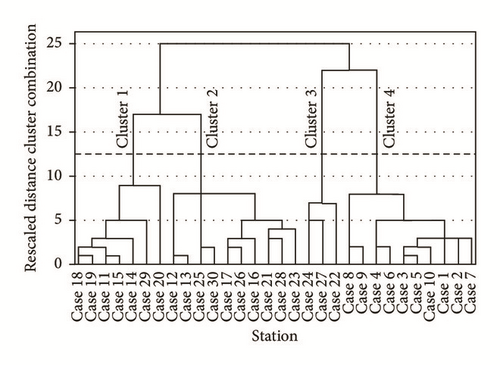
3.3. Principal Component Analysis (PCA)
The PCA was used to explore the most important factors determining the spatial variations in physicochemical parameters of the Batang Baram. A total of six principal components (PCs) were obtained with eigenvalues more than one which accounted for around 83.6% of the total variance in the 20 physicochemical parameters of the Batang Baram (Table 5). The first component (PC1), accounting for 30.0% of the total variance in the data sets of the river water, has significant positive loadings on turbidity, TSS, and H2S and negative loadings on conductivity and transparency. These factors imply that soil erosion occurred in the present study area, and a high loading of turbidity and H2S is associated with the presence of suspended solids [23]. Similarly, strong positive loadings on turbidity and suspended solids were also observed in a Mekong Delta area of Vietnam [11] which is a result of soil erosion from disturbed land. The Sarawak forest is subjected to high timber harvesting pressure rendering sedimentation problem in its forest streams [1, 6, 24–26]. The present study shows that the Batang Baram in Sarawak state is no exception. Logging activities in the surrounding area have caused sedimentation and increased suspended solids level in the river. The PC1 has the largest proportion of the total variance indicating that logging activities are the major source of river water contamination in the Batang Baram.
| Rotated Component Matrixa | ||||||
|---|---|---|---|---|---|---|
| Parameter | Component | |||||
| 1 | 2 | 3 | 4 | 5 | 6 | |
| Total discharge | +0.900 | |||||
| Mean velocity | +0.674 | +0.640 | ||||
| Mean depth | +0.712 | |||||
| Temperature | −0.904 | |||||
| pH | −0.451 | −0.607 | +0.444 | |||
| Conductivity | −0.605 | −0.476 | ||||
| DOsat | −0.750 | +0.488 | ||||
| DO | +0.678 | |||||
| Turbidity | +0.948 | |||||
| Transparency | −0.791 | |||||
| Chl a | −0.906 | |||||
| TSS | +0.956 | |||||
| BOD5 | +0.854 | |||||
| COD | −0.423 | −0.692 | ||||
| TP | +0.850 | |||||
| TAN | +0.780 | |||||
| NO2 | +0.784 | |||||
| NO3 | +0.612 | +0.563 | ||||
| Org-N | +0.716 | |||||
| H2S | +0.759 | +0.427 | ||||
| Initial eigenvalue | 6.0 | 3.7 | 2.7 | 1.7 | 1.4 | 1.2 |
| % of variance | 30.1 | 18.6 | 13.5 | 8.7 | 6.8 | 5.9 |
| Cumulative % | 30.1 | 48.7 | 62.2 | 70.9 | 77.7 | 83.6 |
- aRotation converged in 11 iterations.
The PC2 accounting for 18.6% of the total variance has significant positive loadings on mean velocity, BOD5, TP, -N, and Org-N and negative loadings on pH and DOsat. These factors indicate an inflow of effluent from longhouses and residential area largely consisting of organic pollutants; and a negative loading of pH and DOsat is attributed to the process of decomposition of the organic matter. Similarly, the analysis of PCA was applied in the Qiantang River which indicated that TN, , NH3-N, and TP were the dominant pollution factors in the river [22]. The authors attributed the pollutions to the domestic sewage, discharge of poultry and animal feces, and fertilizer that were flushed into the river. Also, an “organic” factor that positively loaded with COD, BOD5, TON, TP, and was reported in a main river system in northern Greece which represented the influence of municipal and industrial effluents [16]. The PC3 accounting for 13.6% of total variance has significant positive loadings on total discharge, mean velocity, mean depth, DOsat, and DO and negative loadings on conductivity and COD suggesting a dilution of chemically oxidizable material in the river associated with high volume of river water and high dissolved oxygen level. The high COD/BOD5 ratio in the Batang Baram indicates a large nonbiodegradable fraction of organic matter in the river.
The PC4 (8.7% of the total variance) has significant positive loadings on transparency, TAN, -N, and H2S and negative loadings on temperature, pH, and conductivity. In an anaerobic condition, the high loading of organic matter in river can lead to the formation of ammonia and organic acids which coupled with the production of hydrogen sulphide and carbon dioxide during decomposition [27, 28] can cause acidification of water. By employing the PCA for the data interpretation, [10] also revealed that parameters related to organic pollutants and temperature were the most important parameters contributing to water quality variation in the Sava River, Croatia. The PC5 (6.8% of the total variance) is significantly and negatively loaded on COD but positively loaded on -N. Again, the high loading of organic matter in the river likely led to the build-up of -N in the water. Similar to PC2, both PC4 and PC5 can be explained as influences from domestic discharges which contained high nutrients and organic matter. As PC2 has a larger proportion of the total variance than PC4 and PC5, we can assume that organic pollution in the Batang Baram is more severe than the inorganic pollution. Reference [29] also reported that organic pollutants, followed by nutrients and salt concentration, were the most important parameters contributing to water quality variation in the Wen-Rui Tang River watershed, China. Finally, the PC6 (5.9% of the total variance) is significantly and positively loaded on pH but negatively loaded on chl a indicating the decomposition of dead phytoplankton and that most of the variability in the data is due to the pH changes as pH plays a significant role in mineralization process.
4. Conclusions
The present study revealed that the Batang Baram and its tributaries demonstrated sign of pollution as indicated by high suspended solids and nutrients in the river. Most of the stations along the river were classified as Class III and categorized as “slightly polluted.” In particular, the COD and TSS were the most severe parameters where they were classified as Class V at some of the stations in the river. A large number of sampling stations in the present study were grouped into four clusters which divided the river into upstream, middle, and downstream main river and tributaries located middle and downstream of the river. The PCA revealed that parameters related to logging activities and domestic sewage discharge were the most important parameters contributing to water quality variation in the river.
Competing Interests
The authors declare that there is no conflict of interests regarding the publication of this paper.
Acknowledgments
The authors appreciate the financial support provided by the Sarawak Energy Berhad through Grant no. GL(F07)/SEB/3C/2013(22) and the facilities provided by Universiti Malaysia Sarawak.




